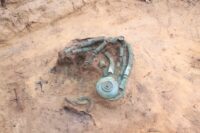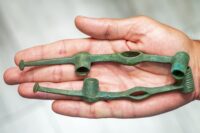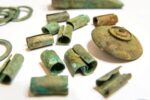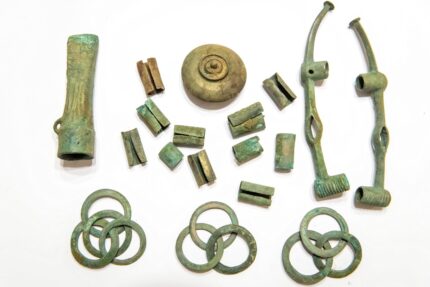 Metal detectorists in north-central Poland have discovered a complete bronze horse bridle that date back 2,500 years. Also buried with the hoard was a bronze axe. This is the first Iron Age horse harness of its kind discovered in Central and Eastern Europe.
Metal detectorists in north-central Poland have discovered a complete bronze horse bridle that date back 2,500 years. Also buried with the hoard was a bronze axe. This is the first Iron Age horse harness of its kind discovered in Central and Eastern Europe.
Arkadiusz Kurij had scanned a forest near Toruń with fellow WELES Historical and Exploration Group members with no success. He returned to the rendezvous point and suddenly his detector signaled loudly. The group began to dig, but stopped when they found the first bronze pieces. WELES explores in cooperation with the Regional Monuments Protection Office (WUOZ) in Toruń, so as soon as they realized they had discovered archaeological artifacts, they notified the authorities and carefully reburied the site to cover up evidence of digging should anybody with less noble intent happen upon it.
 Archaeologists excavated the find site and recovered a highly decorative harness made of numerous tubular elements linked together with rings and decorated with round shields with central bosses. A total of 156 bronze harness parts made of sheet metal and wire were unearthed. It is complete in every particular, missing only the bit that went in the horse’s mouth. Bits found in Scythian horse burials were made of wood, so that one missing piece may have decomposed.
Archaeologists excavated the find site and recovered a highly decorative harness made of numerous tubular elements linked together with rings and decorated with round shields with central bosses. A total of 156 bronze harness parts made of sheet metal and wire were unearthed. It is complete in every particular, missing only the bit that went in the horse’s mouth. Bits found in Scythian horse burials were made of wood, so that one missing piece may have decomposed.
Microtraces of organic remains on the artifacts indicate the fittings and the axe were wrapped in burdock leaves and placed in a leather bag. The bag was then deliberately buried in the sandy soil of a hill near the bank of the Vistula River. The hoard weighs one kilo (2.2 lbs) in total, which was a lot of metal in the Iron Age. The hoard could have been intended to be melted down and used as raw material.
 The design style of the harness is typical of metalwork by the Iron Age Scythian cultures of the Eurasian steppe, perhaps traveling north and west towards the territories of the Lusatian culture. The moved into southern Poland through the Moravian Gate in which is now the Czech Republic during the Late Bronze Age and Early Iron Age (7th-6th century B.C.). The socketed axe found in the cache is of local origin. How it made its way into the harness bag is unknown, but it may suggest encounters between Scythian horsemen and the local population.
The design style of the harness is typical of metalwork by the Iron Age Scythian cultures of the Eurasian steppe, perhaps traveling north and west towards the territories of the Lusatian culture. The moved into southern Poland through the Moravian Gate in which is now the Czech Republic during the Late Bronze Age and Early Iron Age (7th-6th century B.C.). The socketed axe found in the cache is of local origin. How it made its way into the harness bag is unknown, but it may suggest encounters between Scythian horsemen and the local population.
 The objects will be analyzed, studied and conserved by a multidisciplinary team of researchers coordinated by the Institute of Archeology of Nicolaus Copernicus University in Toruń. The team hopes to be able to narrow down the date when the harness was buried. Conservation and analysis is expected to take at least nine months, after which WUOZ hopes the objects will go on display in a local museum.
The objects will be analyzed, studied and conserved by a multidisciplinary team of researchers coordinated by the Institute of Archeology of Nicolaus Copernicus University in Toruń. The team hopes to be able to narrow down the date when the harness was buried. Conservation and analysis is expected to take at least nine months, after which WUOZ hopes the objects will go on display in a local museum.

Every time I see that round piece, I cannot help but think of my bicycle bell.
It would be interesting to see it all set up, as I cannot quite see how those sets of rings would fit.
…in particular, I would like to see the axe mounted onto the Iron Age horse 😉
That ‘knob’ would probably sit somewhere in the middle. An Iron Age ‘headlight’, maybe.
The early Iron Age bronze hoard from Lebus castle hill was found in 2003, weighing around 22 kilograms: 103(!) axes, two rings, a sword fragment and the remainder of a casting process. The town of Lebus (Lubusz) is located on the west bank of the Oder river.
The ‘Vettersfelde Treasure’ or ‘Witaszkowo Treasure’, on the other hand, is a treasure trove found in Vettersfelde in the Province of Brandenburg (modern Witaszkowo, near Gubin, Poland). The objects in the trove are connected to the animal themed art of the Scythians.
:hattip:
————
PS: ‘Statue Menhirs’ and –more or less Scythian– ‘Kurgan’ stelae are quite common. In Upper Franconia, e.g., the ‘Bamberger Götzen’ were in 1858 found dumped into the Regnitz river, while –as late as 1059(!)– clergy in Bamberg still seems to have had problems with Slavic idolatry :no:
———–
..Praeterea festivitates dominicas ceteraques anni solemnitate observandas in parrochiali ecclesia a sacerdote indictas, quicumque aliquo opere temerare praesumpserit vel quicquid tunc laborare praeter id, quod ad domesticum apparatum eiusdem diei indiget, vel qui legitima ieiunia, hoc est [..] aut qui idolothita, quod trebo dicitur, vel obtulerit aut manducaverit, aut qui mortuos non in atrio ecclesiae, sed ad tumulos, quos dicimus more gentilium hougir, sepelierit, [..] canonicis induciis sacerdos eum pro huiusmodi praevaricatione et neglegentia ad poenitudinem invitet…
“..Moreover, the Sundays and other holidays of the year, if they have been announced by the priest in the parish church, must be observed. Whoever takes it upon himself to defile them by any work or then to do anything beyond what is necessary for the household of the day in question, [..] or who either offers or eats sacrifices to idols, which is called ‘Trebo’ [cf. тре́ба, ‘irregular ceremony performed at the request of a parishioner’], or who buries the dead not in the cemetery of a church, but in the Tumuli that we call ‘Hougir’ [cf. “Haug” or “Hügel”] after the way of the pagans, [..] By means of the canonical terms, the priest shall call him to repentance for such presumption and negligence…”
———–